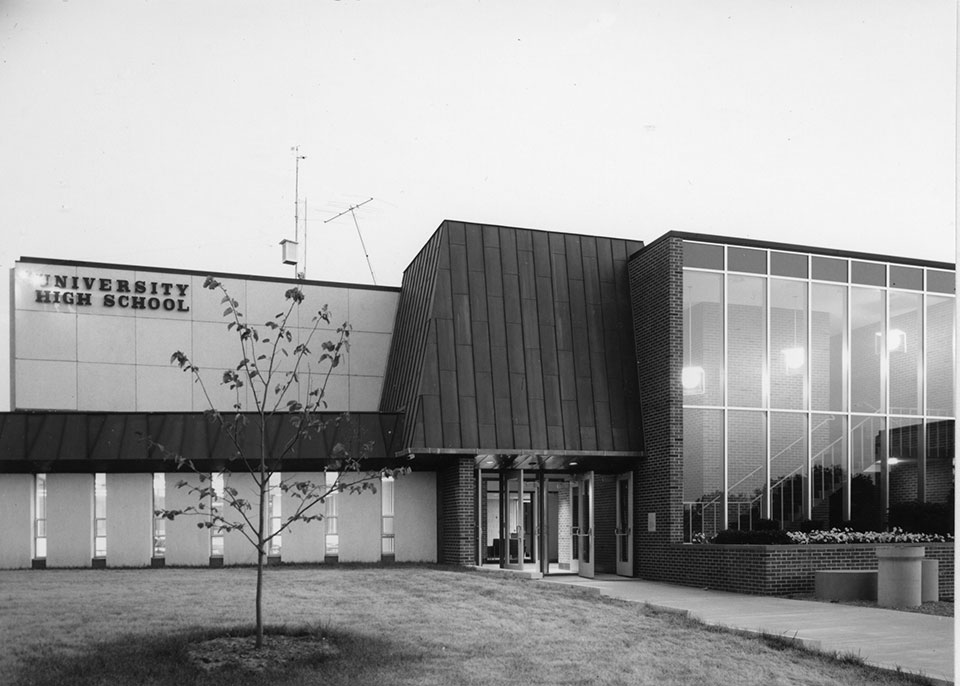At Illinois State Normal University’s (ISNU) founding in 1857, Metcalf grammar school and University High School were opened to give the university’s teaching students hands-on training. The first yearbook for ISNU debuted in 1892, listing students from both the university and the laboratory schools. University High School began printing their own yearbook, The Clarion, in 1929 and has continued to print the annual book to present day.
All of the yearbooks are now available online, thanks to the efforts of the Milner Library’s Digital Collections department and the Dr. Jo Ann Rayfield Archives.
Gretchen Zaitzeff is University High School’s library media specialist. She and the entire U-High community are excited to have The Clarion digitally available.
“These yearbooks are a historical record of the people who have passed through the halls of U-High from its earliest inception on campus to its current location on Gregory and Main,” Zaitzeff said.
“Our yearbooks are one of our most frequently used collections at Milner Library and the University Archives,” Associate Dean of Milner Library Dallas Long said. “We digitized the University’s yearbooks a few years ago, and U High’s alumni asked all the time when their yearbooks were going to be available online. Now they are!”
“We decided to digitize The Clarion yearbooks to make it easier for our patrons to share their memories, research genealogical connections, or be inspired by the timelessness of the University High School community. We have nearly 100 years’ worth of University High School memories in our newest digital collection!” – Dallas Long, associate dean of Milner Library
View the collection!
The Illinois State and University High digital yearbooks are viewed for many reasons.
“We have many people who have lost their own yearbooks over time but want to reconnect with their memories or show their children and grandchildren what they looked like during their college years,” Long explains. “Other alumni are trying to recall the name of their first roommate, or a friend with whom they’ve lost touch. For our much older yearbooks, such as the 1920s and 30s, we have many relatives who use the yearbooks for genealogical research or who are trying to verify family stories.”
Milner Library’s Digital Collections provide access to primary source materials to support teaching, learning and research needs of the University community and worldwide. The Digital Collections feature unique items from the library, including Special Collections, the Circus Collection, University Archives, Government Documents, as well as collections in collaboration with university departments, such as the School of Art and the Department of Sociology and Anthropology. They cover a broad range of topics, periods, and formats, including audio recordings, historical documents, film, photos, and images of art and visual culture. Milner Library is thrilled to collaborate and help share these moments in history.
“Digitization provides families and researchers access to this information wherever they are across the country and around the globe,” says Zaitzeff. “U-High’s impact and legacy have been preserved through the collaborative efforts of archivist April Anderson, her staff, Milner Library, and the ISU Lab Schools. We are so grateful for their support.”
Milner Library supports a variety of digital initiatives to promote easy access to our diverse collections; whether that may be to view the business community in Central Illinois during the 1940s–1960s, read letters written by Buffalo Bill, interpret World War I posters, study 1920s performers from Ringling Brothers and Barnum & Bailey Circus, see Reggie Redbird in the 1970s, listen to political interviews, admire international artwork by children, watch film clips of trapeze acts from the 1930s, interact with a Japanese pottery collection, or read the 1889 edition of The Vidette, our campus newspaper! For more information and a list of all of Milner Library’s Digital Collections, visit www.library.illinoisstate.edu/collections.
Interested in being involved? Help Milner Library improve access by going online to transcribe handwritten diaries, documents, and letters, or identify photos through our Decipher History collections! Transcribing handwritten content and creating captions for previously unidentified photographs allow them to be discoverable in new ways. Decipher History empowers anyone to interact more deeply with history and share it globally.

